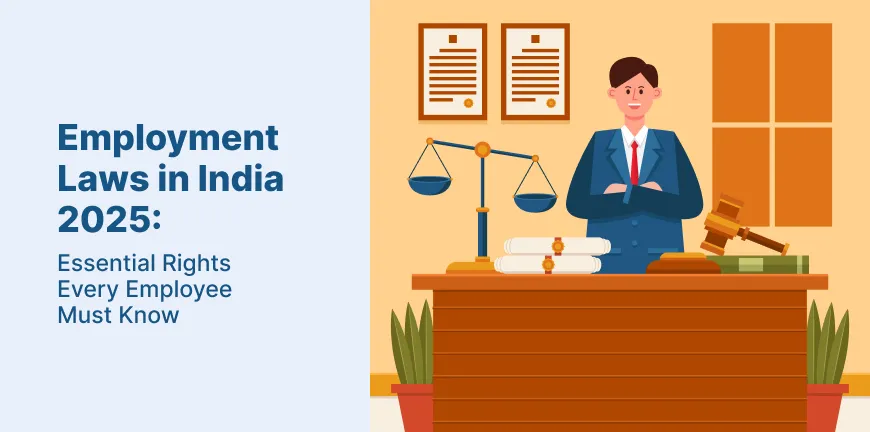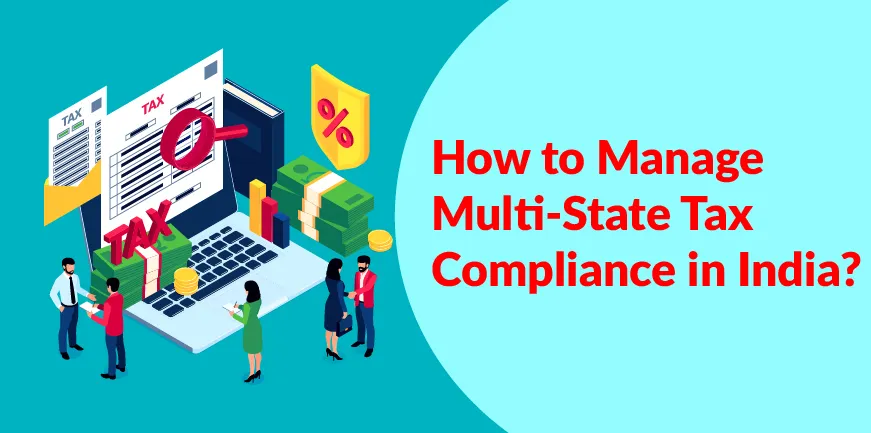
Why Companies Should Opt for NAPS or NATS Scheme in 2026
18/12/2025
21 Key HR Roles and Responsibilities in 2026 – Complete Guide
22/12/2025- Legal Foundation of Employment Laws in India
- Classification of Employees under Indian Labor Law
- Essential Rights under the Employment Contract
- Wages, Working Hours and Overtime Regulations
- Statutory Benefits Every Employee Must Receive
- Protection Against Discrimination and Harassment
- Termination, Retrenchment and Notice Periods
- Recent Reforms and Labor Codes Effective in 2025
- Conclusion
- Key Takeaways
- FAQs
India has the world’s second-largest workforce after China, with over 501 million people employed across the country. The national minimum monthly wage is ₹5,340, and labour laws limit working hours to 12 per day and 48 per week.
Several key laws protect workers’ rights in India. The Minimum Wages Act (1948) ensures fair pay, while the Industrial Disputes Act (1947) governs workplace relations and dispute resolution. The Indian Constitution also guarantees fundamental rights such as equality, privacy, and protection from discrimination.
To simplify and modernize these laws, the government is merging them into four major labour codes:
- Code on Wages (2019)
- Code on Social Security (2019)
- Industrial Relations Code (2020)
- Occupational Safety, Health and Working Conditions Code (2020)
This article explains the key aspects of India’s employment laws that every worker should understand, especially as the nation prepares to implement these new labour codes in 2025.
Legal Foundation of Employment Laws in India
India’s employment laws come from a unique constitutional setup that splits lawmaking power between the central and state governments. This dual system protects workers and meets regional employment needs nationwide.
1. Concurrent List Authority: Central vs State Jurisdiction
Indian employment laws get their power from the Constitution’s Concurrent List, where both Central and State governments have equal rights to create labor laws. This shared power creates a two-tier system. The Central government sets up basic laws, while states develop rules to implement them and add extra regulations.
The Constitution’s Seventh Schedule clearly lays out this power distribution. The Central government controls specific areas like mines, oil fields, and railway workers. States can handle local employment needs by expanding or changing Central laws to fit their requirements.
The Shops and Establishments Acts show this dual system at work. Each state has its own version that controls working hours, wages, leave policies, and service terms. This shared authority sometimes leads to confusion, as seen in Central Public Sector cases where the Supreme Court had to step in to decide which government should implement the rules.
2. Constitutional Articles: Article 14, 16, 19(1)(c), 23, 24
The Indian Constitution includes several basic rights that shape employer-employee relationships.
- Article 14 promises equality before law, which means “equal pay for equal work”. The Supreme Court made this clear in Randhir Singh v. Union of India (1982), making it a constitutional right for all employees.
- Article 16 focuses on equality in government jobs. It bans discrimination based on religion, race, caste, sex, descent, place of birth, or residence. The state can also make special rules to help disadvantaged groups.
- Workers can form associations or unions thanks to Article 19(1)(c). These rights form the foundation of the Trade Union Act of 1926, which lets workers bargain together and fight for their rights.
- Articles 23 and 24 shield workers from exploitation. Article 23 stops human trafficking and forced labor, while Article 24 protects children under 14 from dangerous jobs. The Supreme Court’s decision in Bandhua Mukti Morcha v. Union of India (1984) called bonded labor modern slavery that violates basic human rights.
3. Role of Directive Principles in Labor Legislation
The Directive Principles of State Policy in Part IV of the Constitution (Articles 36-51) shape labor laws significantly. These guidelines help the government create laws, though courts can’t enforce them directly.
Key directives about worker welfare include:
- Article 39(a) asks the state to ensure people can earn a living
- Article 39(d) requires equal pay for equal work across genders
- Article 41 makes the state responsible for work rights and public help
- Article 42 calls for fair working conditions and maternity benefits
- Article 43 pushes for living wages and good living standards
These principles led to many labor laws, like the Minimum Wages Act (1948), Equal Remuneration Act (1976), Maternity Benefit Act (1961), and Child Labor Prohibition Act (1986). Dr. B.R. Ambedkar called these principles “novel features” of the Constitution. They build both social and economic democracy alongside political democracy.
Courts still use these Directive Principles to interpret labor laws, even though they’re not legally binding. These principles have helped shape major court decisions that protect workers’ rights throughout India’s history.
Classification of Employees under Indian Labor Law
Indian labor laws have different categories of employees. This is done to determine the degree of legal protection each worker gets. This system sets up a framework that puts employees into distinct categories, each with its own set of rights and benefits.
1. Definition of ‘Workman’ under Section 2(s) of ID Act
The Industrial Disputes Act, 1947 (ID Act) has a complete definition of “workman” under Section 2(s). The law states that a workman is “any person (including an apprentice) hired in any industry to do manual, unskilled, skilled, technical, operational, clerical or supervisory work for hire or reward”. This definition also covers individuals who lose their jobs due to dismissal, discharge, or retrenchment connected to an industrial dispute.
Several states have added to this definition through amendments. Some examples are-
- Kerala added “any work for the promotion of sales”
- Assam added the same phrase “any work for the promotion of sales”
- Odisha changed the phrase to “sales promotion, operational, clerical or supervisory work or any work for promotion of sales”
The ID Act calls dismissal or termination of an individual workman an industrial dispute under Section 2A, even without union involvement. This is a big deal as it means that individual workers have a stronger position in the legal framework.
2. Managerial and Supervisory Roles: Non-Workmen Category
The “workman” definition leaves out four types of employees. The first group includes those hired “mainly in a managerial or administrative capacity”. The second covers supervisory positions with wages over ₹10,000 monthly. This threshold used to be ₹1,600 before changes. People who handle tasks “mainly of a managerial nature” are also excluded, whatever their job title.
The Supreme Court made it clear that employees don’t become managerial or supervisory just because they get a responsibility allowance.
Non-workmen have their employment terms governed by:
- State-specific Shops and Establishments Acts
- Individual employment contracts
- Internal organizational policies
3. Case-by-case Determination of Employee Status
The Supreme Court has consistently ruled that an employee’s actual duties, not their job title, determine if they qualify as a “workman”. Legal precedent dictates that “the determinative factor for ‘workman’ covered under Section 2(s) of the ID Act is the principal duties and functions performed by an employee in the establishment and not merely the designation of his post”.
The person who claims to be a “workman” must prove their status. Courts look at specific facts like appointment letters, job descriptions, reporting relationships, and daily responsibilities.
For Example, the Karnataka High Court ruled in one case that an Executive Secretary with 17 years of experience earning over ₹30,000 monthly wasn’t a “workman.” Why? Because her duties were mainly managerial and supervisory, despite the title she was given. The Supreme Court also found that a senior manager who led a team and earned ₹2.2 million didn’t qualify for workman status.
Now this classification matters quite a lot.
Workmen get protection under the ID Act for termination, working conditions, and dispute resolution. They can go to labor commissioners and industrial tribunals if they’re fired without cause.
Essential Rights under the Employment Contract
Employment contracts are the life-blood of employer-employee relationships in India. However, requirements differ between states and industries, and both parties need to understand the contractual framework to set clear expectations and legal protections.
1. Written vs Implied Contracts: State-wise Mandates
India’s legal system recognizes both express and implied employment relationships, with no nationwide rule requiring written employment contracts. Courts can enforce verbal agreements in some cases, but without proof and interpretation, this may not be as solid as we expect it to be. Written contracts prove to be much more stable and easier to verify in court.
Some states now require specific written employment documentation:
- Karnataka and Delhi require employers to issue written appointment orders with specific employment terms
- These rules typically apply to commercial establishments under respective Shops and Establishments Acts
The new Occupational Safety, Health and Working Conditions Code 2020, though not yet active, will require employers to issue appointment letters with government-prescribed details. This marks a fundamental change toward standardization in India’s dynamic, ever-changing rules of the employment world.
2. Mandatory Clauses: Wages, Leave, Termination, Dispute Resolution
India doesn’t have a standard format for employment contracts, but to protect all parties certain key elements are necessary:
- Job Description: Clear job title and explanation of position responsibilities
- Compensation Structure: Fixed salary, variable pay, and allowances details
- Duration of Employment: Position status as permanent, temporary, or fixed term
- Termination Provisions: Rules and notice periods for ending employment
- Intellectual Property Rights: Critical for technology, media, and research sectors
- Dispute Resolution Mechanisms: Ways to resolve conflicts through arbitration, mediation, or courts
Some terms automatically apply by law without their explicit mention in contracts. These include statutory provisions for wage payments, bonuses, gratuity payments, and employee provident fund contributions. Workers get the protection as mentioned in the written document.
3. Standing Orders under Industrial Employment Act, 1946
The Industrial Employment (Standing Orders) Act of 1946 creates a complete framework of standard employment conditions for industrial establishments. Employers must “define with sufficient precision the conditions of employment” and communicate these to workers.
This Act covers industrial establishments with 100 or more workers. Although the central government jurisdiction has reduced this to 50 workers. Regional Labor Commissioners, acting as Certifying Officers, must certify standing orders in central sphere establishments.
Standing orders must cover everything listed in the Act’s Schedule:
- Classification of workmen (permanent, temporary, apprentices, etc.)
- Working hours, holidays, and pay day notifications
- Leave application procedures
- Attendance and shift working policies
- Termination procedures and notice periods
- Acts constituting misconduct
- Grievance redressal mechanisms
Certified standing orders must be displayed clearly and must be prominent at workplace entrances and all departments with workmen. Any changes are allowed only after six months through employer-worker agreements.
This framework brings consistency to employment conditions and helps both employers and employees understand their rights and duties. Establishments not under the Act’s purview follow individual contracts and state laws to define their employment terms.
Wages, Working Hours and Overtime Regulations
Wage and hour regulations are the foundation of workplace protection in India’s employment landscape. These rules set basic standards and protect workers from exploitation through detailed legal framework that keep evolving.
1. Minimum Wages Act, 1948 and Code on Wages, 2019
The Minimum Wages Act, 1948, laid the groundwork for fair compensation in India. According to this Act, the government can set minimum wages for scheduled employment in order to ensure fairness and protect worker rights. Workers who put in extra hours are to receive overtime pay at double their regular wage rate.
The Code on Wages, 2019 combines and updates wage regulations replacing four existing laws: the Payment of Wages Act (1936), the Minimum Wages Act (1948), the Payment of Bonus Act (1965), and the Equal Remuneration Act (1976). This indicates the progression of labour reforms.
The Code brings in “floor wages” – a universal minimum wage that no state government can violate or pay less. This gives workers a guaranteed baseline income level in every employment sector. The Code’s implementation protects about 50 crore workers nationwide.
2. Working Hours: 48 Hours/Week and 12 Hours/Day Cap
Indian labor laws set clear limits on standard working hours. The Factories Act, 1948 states adult workers can’t work more than 48 hours per week or 9 hours per day. These numbers help determine when overtime pay kicks in.
Workers must get these breaks:
- A 30-minute break after 5 hours of continuous work
- One full day off every week
The Factories Act limits total workplace time (including breaks) to 12 hours daily. This rule makes sure work duration is reasonable, even with breaks.
Standard working hour rules apply widely, but they’re different across sectors and states. To name just one example, many states use these standards in their Shops and Establishments Acts for commercial and service establishments.
3. Overtime Pay: 100% Premium and State Variations
According to Indian labor laws employers must pay double of the usual payment for overtime work. This applies to both monthly-paid and daily wage workers.
Here’s how overtime pay works:
- Salaried employees get: 2 × [(monthly basic pay + DA + RA) ÷ (total days × maximum daily hours)] × overtime hours
- Hourly workers receive: (Basic pay ÷ total days × maximum hours) × 2 × overtime hours
Most industries cap overtime at 50 hours per quarter, though this limit changes based on state rules and industry needs.
Several states have updated their overtime rules. Southern states like Telangana, Tamil Nadu, and Andhra Pradesh have changed their policies to fit modern workplaces. Some areas now pay overtime only after 48 weekly hours and not for daily work beyond eight hours.
Breaking overtime rules results in heavy penalties. The Factories Act punishes employers who don’t pay overtime wages. This includes up to two years in jail and/or fines up to ₹1,00,000. Each day the violation continues adds ₹1,000 to the fine. The Code on Wages sets similar strict penalties – fines up to ₹50,000 for original violations and up to three months in jail with fines up to ₹1,00,000 for repeat offenses.
Statutory Benefits Every Employee Must Receive
Social security is a vital part of India’s employment laws. It gives workers financial protection throughout their work experience. Worker protection relies on several statutory benefits that ensure economic stability and healthcare access for millions.
1. Employees’ Provident Fund (EPF) and Pension Scheme
The Employees’ Provident Fund Organization runs three important schemes through the EPF & Miscellaneous Provisions Act, 1952. A tri-partite board manages one of the world’s largest social security networks. This board includes representatives from the government (both Central and State), employers, and employees.
The EPF scheme works as a contributory provident fund. Members get their accumulated funds plus interest when they retire, resign, or pass away. They can withdraw part of their funds for specific needs like building a house, higher education, marriage, and medical treatment.
The Employees’ Pension Scheme (EPS) 1995 gives monthly benefits for retirement, disability, and survivors. Your pension amount depends on your average salary in the last 12 months before leaving and total years worked. Since June 2024, members can get withdrawal benefits even with less than 6 months of service.
The third part—Employees’ Deposit Linked Insurance (EDLI)—helps families financially when an employee dies. Right now, families can receive up to ₹3 lakh plus an extra 20% of the calculated benefit.
2. Employees’ State Insurance (ESI) for Medical Coverage
The ESI Act of 1948 created the Employees’ State Insurance Scheme to provide complete medical care and financial protection. This scheme covers workplaces with 10 or more employees who earn up to ₹21,000 monthly (₹25,000 for persons with disabilities).
The scheme runs on joint contributions. Employers pay 3.25% of wages while employees contribute 0.75%. Members get six main benefits:
- Medical care: Complete treatment without spending limits for insured persons and their families
- Sickness benefit: 70% of wages as compensation for up to 91 days yearly
- Maternity benefit: Full wages for 26 weeks with possible extensions
- Disablement benefit: 90% of wages during temporary or permanent disability
- Dependents benefit: Monthly payments to families if death happens due to workplace injury
- Funeral expenses: ₹15,000 paid to dependents or person handling last rites
The scheme now protects about 3.10 crore insured persons and helps 12.04 crore people across India.
3. Gratuity under Payment of Gratuity Act, 1972
The Payment of Gratuity Act, 1972 requires gratuity payments in factories, mines, oilfields, plantations, ports, railway companies, shops, and other places with 10 or more workers. This lump-sum payment shows appreciation for services given.
Workers need five years of continuous service to qualify, unless they die or become disabled. Gratuity equals 15 days’ wages for each completed service year, up to ₹10 lakh. Seasonal establishments pay seven days’ wages per season.
4. Maternity Benefits under Maternity Benefit Act, 1961
The Maternity Benefit Act, 1961 sets employment rules for before and after childbirth. Women get maternity benefits at their average daily wage for 26 weeks. They can take up to eight weeks before delivery.
Women with two or more living children can take up to 12 weeks. The Act also provides:
- ₹1,000 medical bonus if employers don’t give free pre-natal and post-natal care
- Six weeks’ paid leave after miscarriage or medical termination
- Two weeks’ paid leave after tubectomy
- Two daily nursing breaks until the child turns fifteen months
Workplaces with 50 or more employees must have crèche facilities. Women can visit four times daily.
Protection Against Discrimination and Harassment
India’s legal system has created resilient frameworks that protect employees of all types from workplace discrimination and harassment across employment sectors.
1. Equal Remuneration Act, 1976: Gender Pay Equality
The Equal Remuneration Act of 1976 stands as groundbreaking legislation that eliminates gender-based wage discrimination. This Act requires employers to pay men and women workers equally for “same work or work of similar nature”. Employers must provide equal wages and ensure women face no discrimination during recruitment, training, transfers, and promotions.
The Act goes beyond simple wage equality by:
- Stopping gender-based discrimination in hiring processes
- Preventing discriminatory employment conditions
- Making employers maintain pay parity whatever the gender
The Code on Wages, 2019 now includes this legislation and extends these protections to people across the gender spectrum.
2. POSH Act, 2013: Internal Committee and Annual Reporting
The Sexual Harassment of Women at Workplace (Prevention, Prohibition and Redressal) Act, 2013 (POSH Act) offers complete safeguards against workplace sexual harassment. Organizations with 10 or more employees need an Internal Committee (IC) to handle harassment complaints.
The IC must include:
- A Presiding Officer – a senior female employee
- At least two employee members who know law, HR, or social work
- One external member from an NGO or with relevant expertise
Women must make up at least 50% of committee members, and members usually serve three-year terms. Employers must create and share a complete anti-harassment policy, conduct regular awareness programs, and give annual reports to district officers about complaints and actions taken.
3. Transgender Persons (Protection of Rights) Act, 2019
The Transgender Persons (Protection of Rights) Act, 2019 marks a major step forward in protecting transgender individuals from workplace discrimination. The Act clearly bans discrimination in employment matters, including “recruitment, promotion and other related issues”.
The law gives transgender persons the right to be recognized by their self-perceived gender identity. Every establishment must:
- Follow the Act’s provisions
- Provide facilities as regulations require
- Have a complaint officer to handle violation reports
The Act protects against discrimination in nine specific areas, from educational access to employment opportunities, healthcare services, and housing rights. This legislation matches constitutional equality principles and extends workplace protections to an often marginalized community.
These three legal frameworks are the foundations of protection against workplace discrimination. They help make India’s employment world more inclusive and fair for everyone.
Termination, Retrenchment and Notice Periods
Job security is the foundation of employment stability in India. The law strictly regulates termination procedures through detailed legislative safeguards. These protections make sure employees get proper notice and financial compensation if they lose their jobs.
1. Industrial Disputes Act, 1947: Section 25F and 25FF
The Industrial Disputes Act defines retrenchment as job termination for reasons beyond voluntary retirement, retirement age, or disciplinary action. This definition covers layoffs from downsizing, business closure, or workforce reduction.
Section 25F sets three must-have conditions for valid retrenchment:
- Written notice of one month that explains termination reasons (or wages instead)
- Appropriate compensation payment after retrenchment
- Notification to government authorities in prescribed format
Companies with 100+ workers face stricter requirements under Section 25N. They must provide:
- Three months’ written notice (or wages instead)
- Retrenchment compensation at prescribed rates
- Government approval before any retrenchment
Section 25FF gives similar protections to workers when ownership or management changes hands. These workers must receive comparable compensation.
2. Retrenchment Compensation: 15 Days per Year of Service
Retrenchment compensation provides financial security to terminated employees. The law requires payment of 15 days’ average pay for each completed year of continuous service or any part over six months. This calculation includes basic wages, dearness allowance, and other applicable allowances.
Employees qualify for compensation if they:
- Have worked continuously for at least one year
- Worked without breaks (except authorized leave, sickness, legal strikes)
- Were not fired for misconduct
Here’s an example: An employee with 6 years of service who earns ₹30,000 monthly would get about ₹90,000 as retrenchment compensation. The compensation has a ceiling of ₹10 lakh, regardless of service length or salary.
3. Notice Periods: 1-3 Months Based on Role and State
Notice periods differ across India based on state laws, industry practices, and employee categories. The notice period is the time employees must work after resigning or receiving termination notice.
Workers with one year of continuous service must get one month’s notice under the Industrial Disputes Act. This extends to three months for industrial establishments that have 100+ workers.
Different states have their own rules:
- Delhi requires one month’s notice after three months of continuous service
- Karnataka needs 30-60 days depending on seniority
- Maharashtra asks for 30 days’ notice after one year of continuous service
- Tamil Nadu mandates 30 days for employees with six months of service
Management positions usually need 1-3 months’ notice based on their contracts. Employers can choose to pay instead of giving notice, which allows immediate separation while paying for the notice period.
Recent Reforms and Labor Codes Effective in 2025
India’s labor landscape is going through massive changes. Parliament has united four labor codes that will replace 29 existing labor laws. These codes mark the biggest reform in employment legislation we’ve seen in decades.
1. Code on Wages, 2019: Floor Wage and Universal Coverage
The Code on Wages sets a universal minimum wage that covers both organized and unorganized sectors. It brings a new “floor wage” concept that sets the minimum baseline for all states. Workers nationwide will get baseline income protection, and the code bans gender discrimination in wages and recruitment. Workers who earn below certain thresholds can now receive yearly bonuses of 8.33% of their wages or Rs. 100, whichever is higher.
2. Code on Social Security, 2020: Gig and Platform Workers
Indian law now recognizes gig and platform workers officially. The Code defines gig workers as people who earn outside traditional employer-employee relationships, while platform workers find work through online platforms. India’s gig workforce will likely grow from 1 crore in 2024-25 to 2.35 crore by 2029-30. These workers will benefit from dedicated social security funds. Online companies will contribute 1-2% of their yearly turnover to these funds. The e-Shram portal has registered more than 30.98 crore unorganized workers, including 3.37 lakh platform workers already.
3. Industrial Relations Code, 2020: Strikes and Lockouts
Workers and employers must give 14-day advance notice before any strike or lockout. This notice stays valid for 60 days maximum. The code prohibits strikes and lockouts during settlement talks and for 60 days after tribunal proceedings. These rules help balance worker rights with industrial stability.
4. Occupational Safety Code, 2020: Health and Safety Mandates
This Code unites 13 previous laws into one framework. It applies to workplaces with 10 or more employees and all mines and docks. Employers must provide free yearly health checkups to specific worker categories. The Code limits work hours to 8 hours per day.
Conclusion
India’s employment laws are undergoing major reforms designed to make workplaces fairer and compliance easier for everyone. Rooted in the Constitution, these laws balance worker rights with employer responsibilities across both central and state levels.
Employment protections depend on the worker’s category—“workmen” enjoy stronger safeguards than managerial staff. Every job relationship, defined by written or implied contracts, includes key benefits like provident fund, health insurance, gratuity, and maternity leave.
Modern laws also promote equality and safety through measures that prevent discrimination, sexual harassment, and unfair dismissal. The four new labor codes—set to roll out in 2025—will simplify compliance and bring gig and platform workers under formal protection.
In essence, India’s evolving labor system is shaping a more inclusive and secure future for its 501 million-strong workforce, empowering employees through awareness and stronger rights.
Key Takeaways
- Understanding India’s employment laws is vital as the country gears up to introduce four new labor codes in 2025, impacting over 501 million workers.
- Know your job category: “Workmen” enjoy stronger protections than managers, including safeguards against unfair termination and clear dispute resolution processes.
- Claim your benefits: Eligible employees are entitled to provident fund contributions, medical coverage under ESI, gratuity after 5 years of service, and up to 26 weeks of maternity leave.
- Check your work hours and pay: You cannot work more than 48 hours a week or 12 hours a day. Any extra time must be paid at twice your normal rate.
- Stand against discrimination: Laws protect you from unequal pay, sexual harassment (through POSH Act committees), and bias based on gender or transgender identity.
- Know your termination rights: Employers must give 1–3 months’ notice and pay compensation equal to 15 days’ wages for each year of service if termination is valid.
FAQs
1. What are the key changes in India’s labor laws for 2025?
The new labor codes consolidate 29 existing laws into 4 comprehensive codes covering wages, social security, industrial relations, and occupational safety. Key changes include a universal minimum wage, recognition of gig workers, stricter rules on strikes, and expanded safety mandates.
2. What are the fundamental rights of employees in India?
Fundamental employee rights in India include the right to equal pay for equal work, protection against discrimination, safe working conditions, minimum wages, limited working hours with overtime pay, and access to social security benefits like provident fund and health insurance.
3. How are working hours regulated in India?
Indian labor laws limit working hours to a maximum of 48 hours per week and 12 hours per day. Any work beyond these limits must be compensated with overtime pay at twice the regular wage rate.
4. What protections exist against workplace discrimination in India?
India has laws prohibiting gender-based wage discrimination, sexual harassment (through the POSH Act), and discrimination against transgender individuals.
5. What are the rules for termination of employment in India?
Termination procedures in India require employers to provide written notice (typically 1-3 months based on role and state), pay retrenchment compensation of 15 days’ wages per year of service, and in some cases, obtain prior government approval.

Hariharan Iyer
Hariharan Iyer is the Vice President – Operations at ALP Consulting, bringing over 40+ years of experience in HR outsourcing and labour law compliance. He leads end-to-end HRO operations, ensuring process efficiency, statutory compliance, and seamless service delivery for clients across industries. With a strong background in labour law governance and workforce management, Hariharan plays a key role in driving operational excellence and compliance-led HR solutions at ALP Consulting.




